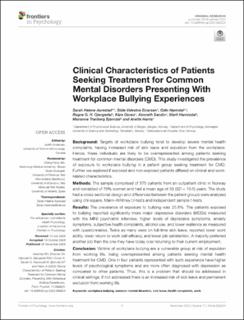| dc.contributor.author | Aarestad, Sarah Helene | |
| dc.contributor.author | Einarsen, Ståle | |
| dc.contributor.author | Hjemdal, Odin | |
| dc.contributor.author | Gjengedal, Ragne Gunnarsdatter Hole | |
| dc.contributor.author | Osnes, Kåre | |
| dc.contributor.author | Sandin, Kenneth | |
| dc.contributor.author | Hannisdal, Marit | |
| dc.contributor.author | Bjørndal, Marianne Tranberg | |
| dc.contributor.author | Harris, Anette | |
| dc.date.accessioned | 2023-01-03T07:56:55Z | |
| dc.date.available | 2023-01-03T07:56:55Z | |
| dc.date.created | 2020-11-06T11:57:03Z | |
| dc.date.issued | 2020 | |
| dc.identifier.issn | 1664-1078 | |
| dc.identifier.uri | https://hdl.handle.net/11250/3040439 | |
| dc.description.abstract | Background: Targets of workplace bullying tend to develop severe mental health complaints, having increased risk of sick leave and expulsion from the workplace. Hence, these individuals are likely to be overrepresented among patients seeking treatment for common mental disorders (CMD). This study investigated the prevalence of exposure to workplace bullying in a patient group seeking treatment for CMD. Further we explored if exposed and non-exposed patients differed on clinical and work-related characteristics.
Methods: The sample comprised of 675 patients from an outpatient clinic in Norway and consisted of 70% women and had a mean age of 39 (SD = 10.5) years. The study had a cross-sectional design and differences between the patient groups were analysed using chi-square, Mann–Whitney U-tests and independent sample t-tests.
Results: The prevalence of exposure to bullying was 25.8%. The patients exposed to bullying reported significantly more major depressive disorders (MDDs) measured with the MINI psychiatric interview, higher levels of depressive symptoms, anxiety symptoms, subjective health complaints, alcohol use, and lower resilience as measured with questionnaires. Twice as many were on full-time sick leave, reported lower work ability, lower return to work self-efficacy, and lower job satisfaction. A majority preferred another job than the one they have today over returning to their current employment.
Conclusion: Victims of workplace bullying are a vulnerable group at risk of expulsion from working life, being overrepresented among patients seeking mental health treatment for CMD. One in four patients represented with such experience have higher levels of psychological symptoms and are more often diagnosed with depression as compared to other patients. Thus, this is a problem that should be addressed in clinical settings. If not addressed there is an increased risk of sick leave and permanent exclusion from working life. | en_US |
| dc.language.iso | eng | en_US |
| dc.rights | Navngivelse 4.0 Internasjonal | * |
| dc.rights.uri | http://creativecommons.org/licenses/by/4.0/deed.no | * |
| dc.title | Clinical characteristics of patients seeking treatment for common mental disorders presenting with workplace bullying experiences. | en_US |
| dc.title.alternative | Clinical characteristics of patients seeking treatment for common mental disorders presenting with workplace bullying experiences. | en_US |
| dc.type | Peer reviewed | en_US |
| dc.type | Journal article | en_US |
| dc.description.version | publishedVersion | en_US |
| dc.source.volume | 11 | en_US |
| dc.source.journal | Frontiers in Psychology | en_US |
| dc.identifier.doi | 10.3389/fpsyg.2020.583324 | |
| dc.identifier.cristin | 1845579 | |
| dc.relation.project | Norges forskningsråd: 250127 | en_US |
| cristin.ispublished | true | |
| cristin.fulltext | original | |
| cristin.fulltext | original | |
| cristin.qualitycode | 1 | |

